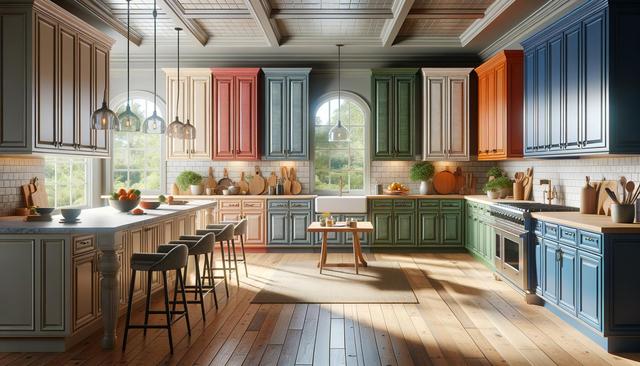Warm Neutrals: A Return to Soft Simplicity
Warm neutrals are gaining renewed attention in kitchen design for 2025, offering a calm and inviting atmosphere. These hues—ranging from creamy whites to soft beiges and muted taupes—bring a sense of timelessness that works well across a variety of kitchen styles. Whether used in traditional or contemporary settings, warm neutrals create a versatile canvas that allows other design elements, such as countertops and backsplashes, to shine. Their understated elegance makes them particularly appealing to homeowners seeking a light, clean look without the starkness of cooler whites. Popular warm neutral tones include:
- Ivory and cream for a soft, sunlit feel
- Beige with pink or peach undertones for added warmth
- Greige (a blend of gray and beige) for a modern twist on a classic
These colors are especially effective when paired with natural materials like wood or stone, enhancing the overall warmth of the space. The adaptability of warm neutrals also makes them an excellent choice for resale value, as they appeal to a wide range of tastes.
Sage Green: Natural and Restorative
Sage green continues to grow in popularity as homeowners gravitate toward colors that evoke nature and tranquility. This muted, earthy green is ideal for creating a soothing kitchen environment and pairs beautifully with both light and dark accents. In 2025, sage is expected to be a favorite among those embracing organic textures and sustainable design choices. The subtle tone of sage green lends itself well to a variety of cabinet types, from sleek flat-panel designs to classic shaker styles.
When incorporating sage green into your kitchen, consider complementary elements such as:
- Brass or matte black hardware for contrast
- Butcher block or marble countertops
- Textured backsplashes in neutral tones
Sage green cabinets can either dominate the space or serve as an accent on a kitchen island or lower cabinets. Its flexibility and calming aesthetic make it a standout choice for those seeking a balance between color and subtlety.
Navy Blue: Bold Yet Timeless
Navy blue is a color that effortlessly combines drama with elegance, making it a popular choice for kitchen cabinetry in 2025. This deep, saturated hue adds depth and sophistication to any kitchen design, whether used across all cabinetry or as a striking contrast on an island or pantry wall. Navy works particularly well in kitchens with ample natural light, where its richness can be fully appreciated without darkening the space too much.
Pairing navy blue with the right materials will enhance its visual impact:
- White or light gray countertops for contrast
- Gold or polished nickel hardware for a touch of glamor
- Natural wood flooring to ground the space
For those who enjoy bold design choices without sacrificing longevity, navy blue offers a confident yet classic look. Its versatility means it can be styled to feel coastal, contemporary, or even traditional, depending on surrounding elements.
Charcoal Gray: Modern and Sophisticated
Charcoal gray is emerging as a go-to color for homeowners seeking a sleek, contemporary kitchen. This darker neutral adds a sense of luxury and refinement, especially when used in matte or satin finishes. Charcoal gray cabinets offer a strong visual anchor and work beautifully in open-concept spaces that benefit from defined focal points. While it may appear bold, charcoal gray is surprisingly adaptable, pairing well with a wide range of colors and textures.
Consider these design combinations when using charcoal gray cabinetry:
- Concrete or quartz countertops for a modern industrial feel
- Wood accents to soften the overall look
- Glass or metallic backsplash tiles for a hint of sparkle
Charcoal gray is particularly effective in kitchens with minimalist designs, where clean lines and simple hardware can enhance its modern appeal. It also serves as a grounding color in two-tone setups, often used for lower cabinets with lighter uppers.
Two-Tone Cabinets and Natural Wood Accents
Two-tone cabinets continue to make waves in kitchen design, offering a dynamic and visually engaging alternative to single-color schemes. In 2025, mixing colors and materials will be a prominent trend, with combinations like white uppers and wood-tone lowers or navy paired with warm neutrals. This approach allows homeowners to experiment with color while maintaining a balanced and cohesive look. It’s especially useful in defining different zones within an open-plan kitchen.
Popular two-tone combinations include:
- Soft white uppers with light oak or maple lowers
- Sage green base cabinets with creamy wall cabinets
- Charcoal gray islands with warm beige surrounds
Natural wood tones are also making a strong comeback, either as part of a two-tone scheme or as standalone cabinetry. These finishes highlight the beauty of organic materials and add warmth and texture to the kitchen. Whether in the form of rift-sawn oak, walnut, or reclaimed wood, natural finishes bring an earthy, timeless quality that complements today’s trend toward sustainable, grounded design.
Conclusion: Choosing the Right Cabinet Color for Your Kitchen
As kitchen design continues to evolve in 2025, color plays a key role in reflecting both personal style and broader design trends. Whether you’re drawn to the calming effect of sage green, the richness of navy blue, or the timeless appeal of warm neutrals and natural woods, there’s a palette that suits every aesthetic. Two-tone cabinets, in particular, offer flexibility and creativity, allowing for a customized look that adapts to different tastes.
When selecting a cabinet color, consider your kitchen’s natural light, surrounding finishes, and overall design goals. The most successful kitchens often combine function with visual harmony, and choosing the right color scheme is a crucial step in achieving that balance. With so many thoughtful options emerging in 2025, homeowners have the opportunity to create spaces that feel both current and enduring.


